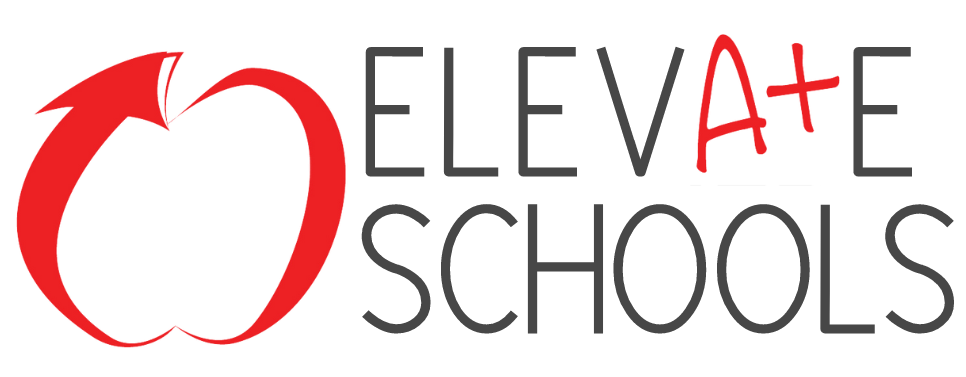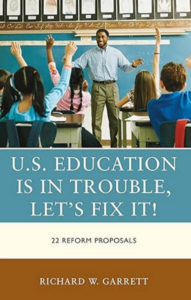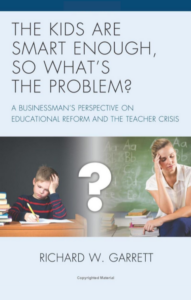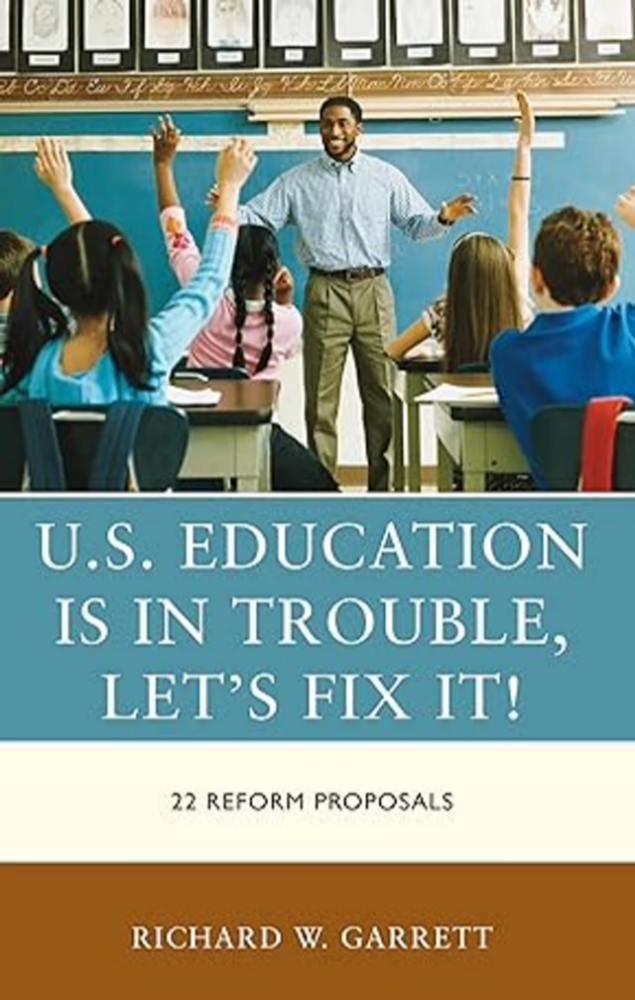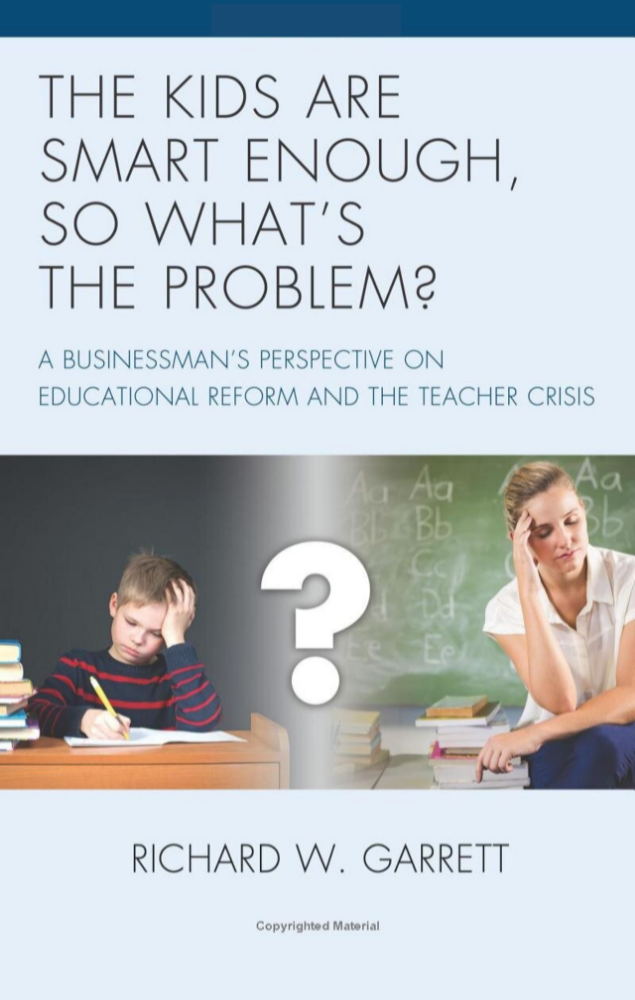An Education Reform Double Feature
Reviews Exploring Proven Paths to Student Success
Vincent A. Mabert, Ph.D.
Review: Let me paint you a picture from personal knowledge: Students hitting other students. Students throwing things in class. Fist fights in hallways. Students screaming at the top of their lungs and cussing back at teachers. Students are out of control! Read more
Michael B. Colegrove, Ph.D.
Review: U.S. Education is in Trouble, Let’s Fix It! 22 Reform Proposals by Richard W. Garrett is a groundbreaking book that delves into the complexities of the American education system and offers innovative solutions for improving it. With meticulous research read more
U.S. Education Is In Trouble, Let’s Fix It!
22 Reform Proposals
by Richard W Garrett
The crisis in the United States education system is at an all-time high. This follow-up book details 22 proven reform proposals that any school system can impement.
The Kids Are Smart Enough, So What’s The Problem?
by Richard W Garrett
This book explores the education system from a business perspective, utilizing data to demonstrate that classrooms across the country are impacted by a small percentage of disruptive students.
Book Reviews
Vincent A. Mabert, Ph.D. Review
Let me paint you a picture from personal knowledge: Students hitting other students. Students throwing things in class. Fist fights in hallways. Students screaming at the top of their lungs and cussing back at teachers. Students are out of control!
These outrageous behaviors aren’t unique or rare. They have increased over the last four decades and many teachers are no longer willing to tolerate in-your-face disrespect. Teachers are quitting and this is the exact experience of my daughter. She received a Master’s degree in Education, taught elementary students for eight years in Florida, received a number of teaching awards, but eventually became emotionally drained, and ultimately left the profession like many of her colleagues.
This personal example is just one of the many issues raised by Richard Garrett in his book U.S. Education Is In Trouble, Let’s Fix It! 22 Reform Proposals. Dr. Garrett stresses that public education in the United States is in crisis and the likelihood of improvement is remote without major effort to correct the system. He presents significant information that lays out fundamental weaknesses and issues impacting education in the United States from cultural thinking and educational structure to policies and financing. The book contains seventeen chapters, covering a wide range of topics. I will not attempt to summarize each chapter but want to address below my perception of the major take-a-ways, plus his suggested pathway forward.
Cultural thinking is a broad term used to cover several points Dr. Garrett discusses to address how things have spiraled down. He first notes the “the self-esteem movement” that took hold in the 1970s. Under this concept, we want the student to feel good about and him/herself. Schools and communities bought into this misguided approach by protecting children from failure and feeling bad about themselves. A variety of outcomes resulted from this approach like grade inflation, where over 40% of children receive the letter grade ‘A’. What is the message young people can interpret from this kind of outcome? It is obvious that they do not have to work hard to find success, wealth, etc. They will not experience failure, learn by their mistakes, or develop grit to deal with adversity.
Classroom culture and student discipline have dramatically changed. One meaning of discipline is training or experience that helps shape a student’s thinking. It helps create an orderly and controlled environment to promote more effective learning environment, so students learn self-control, develop
skills to make good choices, and work well with others. Unfortunately, as noted above, respect and discipline have vanished from the classroom in many cases. Numerous policies have been adopted and legal decisions have been made to determine what is allowed in the classroom, and in most cases there no way a teacher can reprimand a student for inappropriate behavior. However, the teacher still has to deal with the disruptive student. Therefore, the learning environment has been sabotaged by a few
unruly students, with conscientious students losing value learning time.
Education Structure in the United States is not 100% uniform, but it is close. Most boards of education oversee the schools in their communities. They are populated with elected officials, representing different perspectives of the community. In most cases, parents of students populate the board and address issues they feel are appropriate for their children. Unfortunately, they do not always address the needs of a broader perspective to educate young minds. In many cases, they have an agenda to support their direct offspring, especially if they have some deficiency. This makes the implementation of policy within the school corporation problematic. Additionally, most school corporations have unions representing their teachers. These unions have an agenda that are not really focused on students, but on the teacher constituency, with work rules, retention, seniority, and salary issues being of primary interest.
Educational policies govern much that can take place in the in the classroom. There are numerous directives from national, state, and local levels that Dr. Garrett discusses. However, they do not lead to the creation of an effective learning outcome. Probably the most useful policy/directive should focus on the initiation of learning for a young person. As noted in Dr. Garrett’s book, the primary education objectives of guiding a three-year old child’s growth should see they receive the proper amount of brain stimulation. Both home and pre-K are critical starting points for long run success. Receiving the right kind of guidance at an early age is the foundation for long term success in any form of learning and molding of character.
At the secondary education level, Dr. Garrett suggests that curriculum tracking in schools would have better results for students. Designing curriculum that requires all students to take the same material is unrealistic, since students vary in capacity. Not all individuals have the same aptitude and skill to master advanced science and mathematics. Those individuals who have advanced capabilities should be tracked into college preparation coursework. Others not needing certain math and science skills, might be better suited to go into certificate vocational training.
Financial Impact of education, as stated by Dr. Garrett, is central to the student and the United States as a whole. The American student must master knowledge, gain lifelong skills, and develop the fortitude to succeed. These ingredients are necessary for success. As shown in many a study, a good education is the pathway to financial reward. In a similar way, the country as a whole benefits by a better educated society. They can create innovative ideas, foster cohesive work groups, and develop a common focus for improvement. As stated in on page 115 of Dr. Garrett’s book, “The quality of schooling in the country is a reliable predictor of the wealth that country will produce in the long run”.
While billions of dollars are spent annually for education in the United States, much is not focused on the primary goal of supporting the teacher in the classroom. The mission should have teachers maximize their platform time in front of the student, providing critical instruction. However, Dr. Garrett notes a number of government agencies require completing paperwork that takes away valuable time from the teacher, increasing the burden of their workload. Also, increasing the number of administrative staff in school corporations has significantly reduce the available funding for direct support in the classroom.
While I have attempted to provide an overview of the more critical items noted by Dr. Garrett in his book, he has done an excellent job of collecting data and researching the many issues concerning the complex task of educating young people. While it is easy to identify problems and shortcomings, he also puts forward a pathway for improvement. He describes the success in the state of Massachusetts to improve the quality of education for all students and the financial impact for the state. Not done
overnight and requiring strong legislative support to fund and monitor progress. But it worked!
If you are interested the United States public education system, this book is an important read, exploring the many facets that control this critical function in our society. Public education clearly needs improvement, and understanding all the issues and stakeholders is important.
Michael B. Colegrove Review
U.S. Education is in Trouble, Let’s Fix It! 22 Reform Proposals by Richard W. Garrett is a groundbreaking book that delves into the complexities of the American education system and offers innovative solutions for improving it. With meticulous research and insightful analysis, Garrett presents a compelling argument for overhauling the education system better to prepare students for the challenges of the 21st century.
At the heart of the book is Garrett’s unwavering belief in the importance of education as a cornerstone of a thriving society. He astutely observes the current system’s shortcomings, from inadequate funding to outdated teaching methods, and presents a comprehensive blueprint for reform. What sets Garrett’s work apart is his ability to distill complex issues into accessible and actionable recommendations, making it an essential read for educators, parents, policymakers, and anyone invested in the future of education.
One of the most compelling aspects of U.S. Education is in Trouble is Garrett’s meticulous research and data-driven approach. He utilizes a wide range of sources, from academic studies to real-world examples, to support his arguments and offers a comprehensive assessment of the current state of education in the United States. This evidence-based approach lends credibility to his proposals and highlights the urgent need for change.
Garrett’s writing is engaging and persuasive, making complex issues accessible to a broad audience. He skillfully weaves personal anecdotes, case studies, and expert opinions to present a compelling narrative that drives home the urgency of reform. By grounding his arguments in real-world examples, Garrett effectively illustrates the impact of current educational practices on students and society at large, fostering a sense of empathy and understanding for the challenges educators and students face.
One of the most striking aspects of U.S. Education is in Trouble is Garrett’s willingness to challenge conventional wisdom and propose bold, innovative solutions. He advocates for a holistic approach to education that encompasses academic subjects but also social and emotional learning, critical thinking skills, and vocational training. By emphasizing the importance of a well-rounded education, Garrett advocates for a more inclusive and equitable system that empowers all students to reach their full potential.
Garrett’s book is not merely a critique of the current system but a call to action for educators, policymakers, and the broader community. His proposals are pragmatic, actionable, and backed by evidence, making them an invaluable resource for anyone seeking to effect positive change in education. Whether advocating for greater parental involvement, promoting teacher professional development, or reimagining the role of technology in the classroom, Garrett offers a multifaceted approach to transforming education that is both visionary and practical.
U.S. Education is in Trouble is not a pessimistic diagnosis of the state of education but rather an optimistic manifesto for change. Garrett’s unwavering belief in the potential of the education system to be a force for positive social transformation is evident throughout the book, inspiring readers to take an active role in shaping the future of education. By presenting a compelling vision for a more equitable, inclusive, and effective education system, Garrett’s book ignites a sense of hope and possibility for the future of education in America.
In conclusion, U.S. Education is in Trouble. Let’s Fix It by Richard W. Garrett is a landmark work that offers a compelling analysis of the current state of education in America and presents a visionary roadmap for reform. With its rigorous research, persuasive writing, and innovative solutions, the book is a must-read for anyone invested in the future of education. Garrett’s impassioned call to action and unwavering optimism make this book an essential resource for educators, policymakers, parents, and anyone seeking to champion the transformative power of education. It is a timely and urgent manifesto for change that will undoubtedly shape the national conversation around education for years to come.
Dr. Michael B. Colegrove
University of the Cumberlands
VIce President Emeritus
Professor of Education
